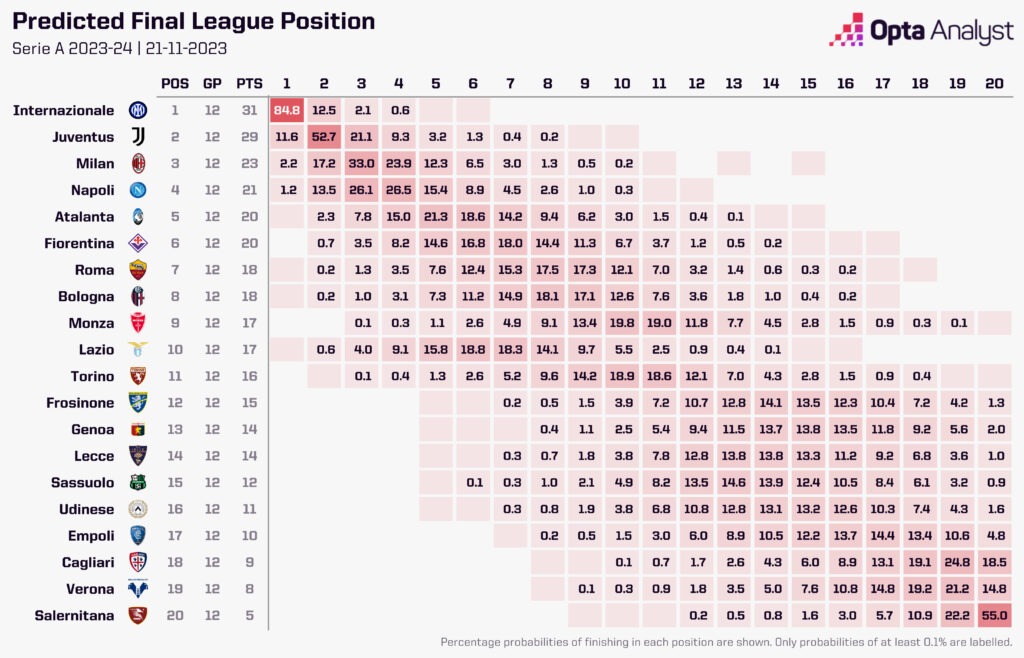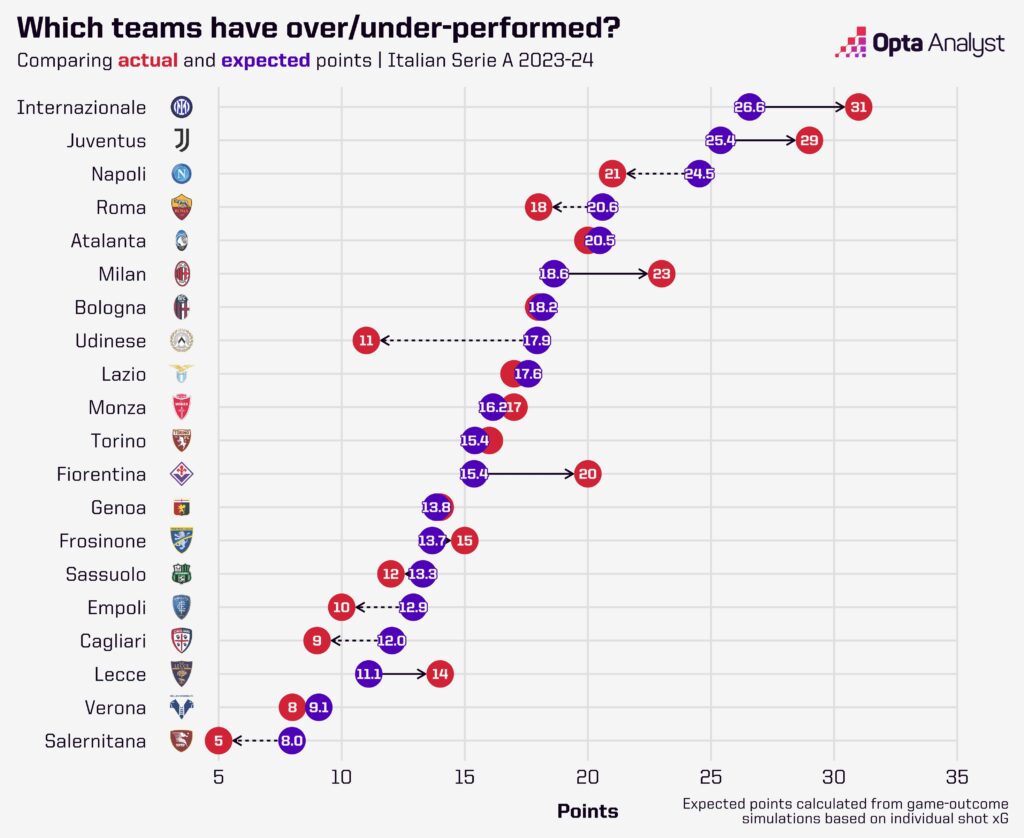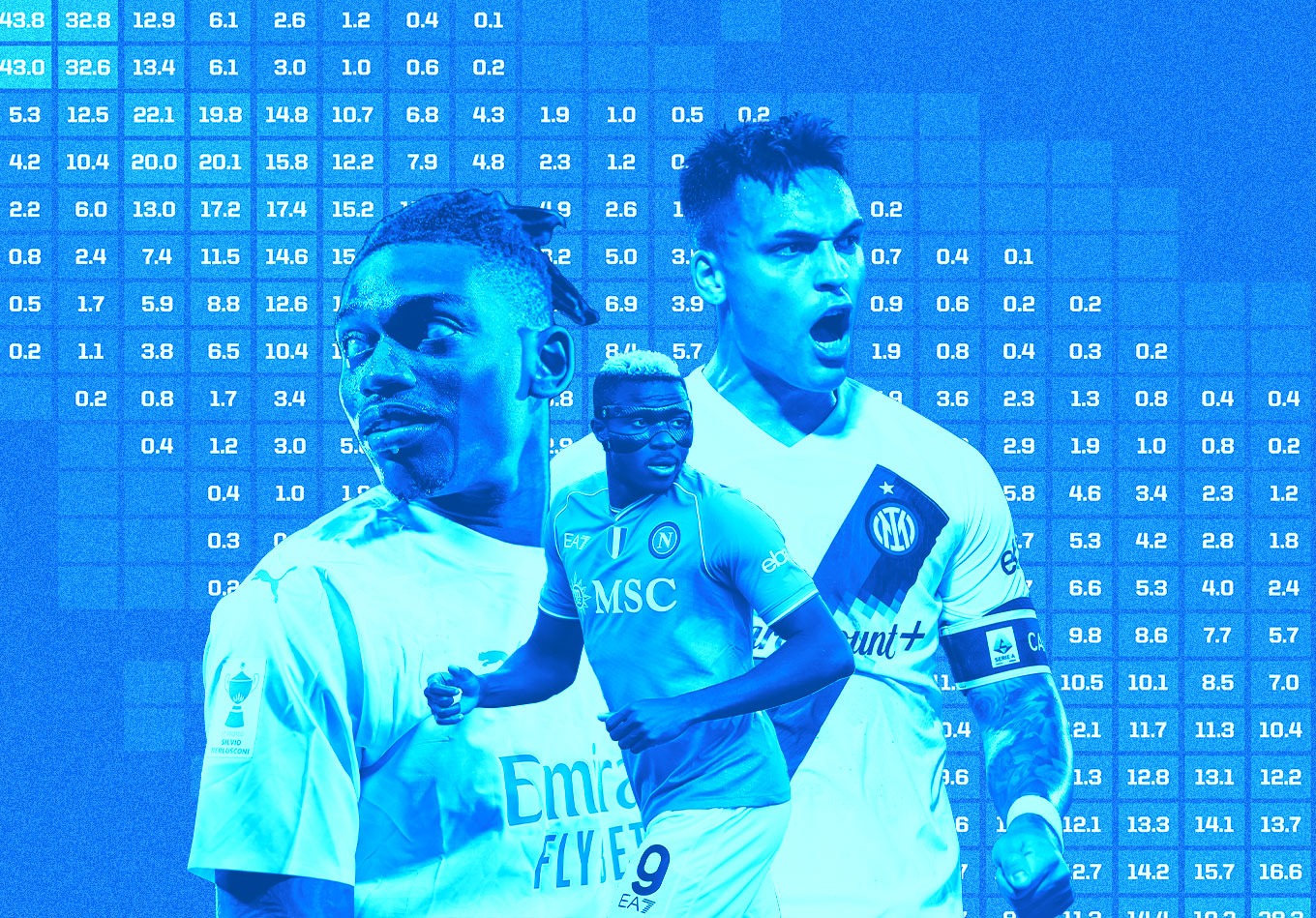With 12 games played and a two-horse title race developing, what will happen in Italy’s top flight from here? We look again at all the key questions with our Serie A 2023-24 season predictions via the Opta supercomputer.
Serie A Season Predictions: The Quick Hits
Title Favourites: Inter
Top Four: Juventus, Milan, Napoli
Relegation Candidates: Hellas Verona, Cagliari, Salernitana
Prior to the 2023-24 season kicking off in August, we asked the Opta supercomputer to predict how the Serie A campaign would play out. It came back and told us that Inter Milan would lead the way, and so far, it’s not wrong.
With 12 games played, we thought it was time we went back and reviewed how things are moving on, so have asked the supercomputer to work its magic again and give us some updated numbers.
Here, we run you through the new percentage likelihood of teams challenging for the title, making the European spots, and fighting against relegation.

Who Will Win Serie A in 2023-24?
We are almost a third of the way through the season, but according to the Opta supercomputer, there is already a 96.3% chance that either Inter or Juventus will be claiming the Scudetto in 2023-24.
Not without reason. Juve trail Inter by two points at the top, with Milan six points behind Massimiliano Allegri’s men in third.
Inter have won 10 of their 12 games so far, with their only dropped points coming in a home defeat to Sassuolo and an away draw in Bologna. Their 5-1 dismantling of neighbours Milan in September was a statement win, and Simone Inzaghi’s side have carried on from there.
Juventus seemed out of sorts heading into the campaign given last season’s points deduction and a lack of European football, but that seems to have played in their favour. The Bianconeri also suffered their only league defeat against Sassuolo, as well as drawing with Bologna and Atalanta, but five wins in a row have seen them pull away with Inter at the top.
Juve and Inter face off on Sunday at the Allianz Stadium in the Derby d’Italia in what already feels like a big clash to decide the title. Heading into it, though, the Nerazzurri are heavy favourites to lift the Scudetto at the season’s end. The Opta supercomputer made them favourites before a ball was kicked in 2023-24 (43.8%), and has almost doubled their chances to 84.8%, while Juventus are up to an 11.6% probability from 4.2% at the start of the season.
Elsewhere, we’re already talking about outsiders. Milan would normally be fairly satisfied with third place, but being eight points off the lead is primarily why they have just a 2.2% chance, while in 10,000 simulations, Napoli only managed to fight back and retain their title 1.2% of the time.
That is quite the drop from the 43% of simulations at the start of the season in which they did repeat the trick and win the title. Khvicha Kvaratskhelia and co will be hoping to get a boost from the return of former boss Walter Mazzarri after Rudi Garcia was dismissed last week, but it’s already a big ask to claw back the 10-point gap to the top.
As for the rest, just four other teams are given any chance by the supercomputer. Atalanta’s 0.06% is followed by Lazio (0.05%), Bologna (0.02%) and Roma (0.01%).

Who Will Qualify for Europe?
Unsurprisingly, Inter (99.9%) and Juventus (94.8%) are considered near certainties for a top-four finish after their starts.
Milan and Napoli might be a way off in the title race but both can at least try and cement their place in the UEFA Champions League spots. Despite having not won any of their last four Serie A games (D2 L2), the Rossoneri still have a 76.3% chance of a top-four finish, while Mazzarri will have to figure out how to win at the Stadio Diego Armando Maradona if he is to maintain or even improve his team’s 67.3% chance of securing Champions League football for next season. Napoli haven’t won any of their last three home matches in the league (D1 L2). Things won’t start easily for him either, with his first three games coming against Atalanta, Inter and Juventus.
Speaking of Atalanta, they qualified for the Champions League in just over a quarter of the 10,000 season simulations (25.2%), and have a 65.0% overall chance of ending the season with qualification for the Champions League, Europa League or Europa Conference League.
It has been a stuttering start to the campaign for Lazio, who sit in 10th place having lost five of their 12 games so far (W5 D2), but they are still considered to have a 13.8% likelihood of a top-four finish, and 48.4% of qualifying for Europe overall. It might sting Fiorentina, four places and three points above them, that the Opta supercomputer doesn’t rate their chances quite as highly as Lazio’s, with a 12.4% possibility of top four and 43.8% of a European finish.
Things didn’t start well this season for José Mourinho and Roma, winning just one of their first six Serie A games (D2 L3) but they have recovered in recent weeks, winning four of their last six, with their only dropped points coming away to Inter and Lazio. They were only able to reach the top four in 5.0% of simulations, though, and only finished in the European spots a quarter of the time (25%).
Elsewhere, eighth-place Bologna have a 22.8% chance of European qualification, while there are honourable mentions for Torino (4.4%) and Monza (4.2%).
Who Will be Relegated from Serie A in 2023-24?
It’s not looking too good for Salernitana. An opening-day draw at Roma was a promising start, but 12 games in and they’re still looking for their first win (D5 L7). Filippo Inzaghi replaced Paulo Sousa as manager but little has changed so far, and the Opta supercomputer isn’t convinced anything will as it gives Salernitana an 88.1% chance of going down.
Cagliari are back in Serie A this season, but perhaps not for long. They sit just inside the relegation zone after winning just two of their 12 games (D3 L7) and were relegated back to Serie B in 62.5% of simulations.
Unsurprisingly, the team sandwiched between Salernitana and Cagliari – Hellas Verona – are the other favourites for the drop, heading down 55.1% of the time. Like the former, they started the campaign well enough, with back-to-back wins over Empoli and Roma, but have not won since in Serie A, drawing two and losing eight, including each of their last six.
Empoli are given a 28.8% chance of going down, while newly-promoted Genoa will probably be quite pleased that they only have a 16.8% likelihood of heading straight back to Serie B.
Udinese (13.3%) and Frosinone (12.8%) are considered the next likeliest, both probably given the benefit of the doubt given how well the latter have taken to the top flight since promotion and the former’s general underperformance, which we’ll come to shortly.
Lecce (11.4%) and Sassuolo (10.3%) make up the bulk of the rest, which seems fairly surprising for the latter given they have wins over both Inter and Juventus under their belt this season. The problem is the only other team they have beaten is Verona, while they have lost six and drawn three of the rest.
Outside of those teams, no other is considered to have a greater than 1% chance of relegation, though it might be of interest to Mourinho that his Roma team are still considered to have a 0.03% chance of going down. Surely not…
Serie A Expected Points

Our expected points model simulates the number of goals scored by each side in each match based on the expected goals (xG) value of every shot taken. It then uses the simulated number of goals to determine the match outcome (win/draw/loss), with each game run through the model 10,000 times. The expected points for each team in every match can then be calculated based on the proportion of simulations they win/draw/lose. This is of course not an exact science, as xG data doesn’t include a lot of factors, such as game state and dangerous periods of possession that don’t lead to shots.
Looking into expected points in Serie A, perhaps the title race should have a third team at this point, with Rudi Garcia arguably unlucky to have lost his job at Napoli as his now former team should apparently have 25 points instead of 21, while Inter (27) and Juventus (25) have overperformed against their expected points.
Milan are actually also overachieving, with just 19 expected points, and should be below Napoli as well as both Atalanta and Roma (both 21).
Fiorentina are another who have more points than expected (15), helped by scoring 20 goals from a total xG of 12.67, while some teams near the bottom of the table can consider themselves unlucky. Each of the bottom six are underperforming against their expected points, with Salernitana three points behind their expected total of eight, Verona a point worse off and Cagliari and Empoli both three worse off.
Udinese are a whopping seven points behind their expected points though, which suggests either they have been incredibly unlucky and a turn in form is just around the corner, or they simply don’t have the goalscorers necessary, having found the net just eight times from an xG of 15.64.
Opta-Simulated Serie A 2023-24 Table
After simulating the remainder of the 2023-24 season 10,000 times, we’re able to average the points total of every club across those simulations and therefore rank teams positionally. Here’s the Opta supercomputer results from those simulations:
1st: Inter
2nd: Juventus
3rd: Milan
4th: Napoli
5th: Atalanta
6th: Lazio
7th: Fiorentina
8th: Roma
9th: Bologna
10th: Monza
11th: Torino
12th: Sassuolo
13th: Lecce
14th: Frosinone
15th: Udinese
16th: Genoa
17th: Empoli
18th: Hellas Verona
19th: Cagliari
20th: Salernitana
How Does the Opta Supercomputer Model Work?
- Opta’s League Prediction model estimates the likelihood of teams finishing in each position in the competition. We can therefore see how successful a team’s season is likely to be, whether it is their relegation or title chances.
- The model estimates the probability of each match outcome (win, draw or loss) by using betting market odds and Opta Power Rankings. The odds and rankings are based on historical and recent team performances.
- The model considers the strength of opponents by using these match outcome probabilities and simulates the remaining fixtures in the competition thousands of times. By analysing the outcome of each of these simulations, the model can see how often teams finished in each league position to create final predictions.
Enjoy this? Subscribe to our mailing list to receive exclusive weekly content. And follow us on Twitter too.
